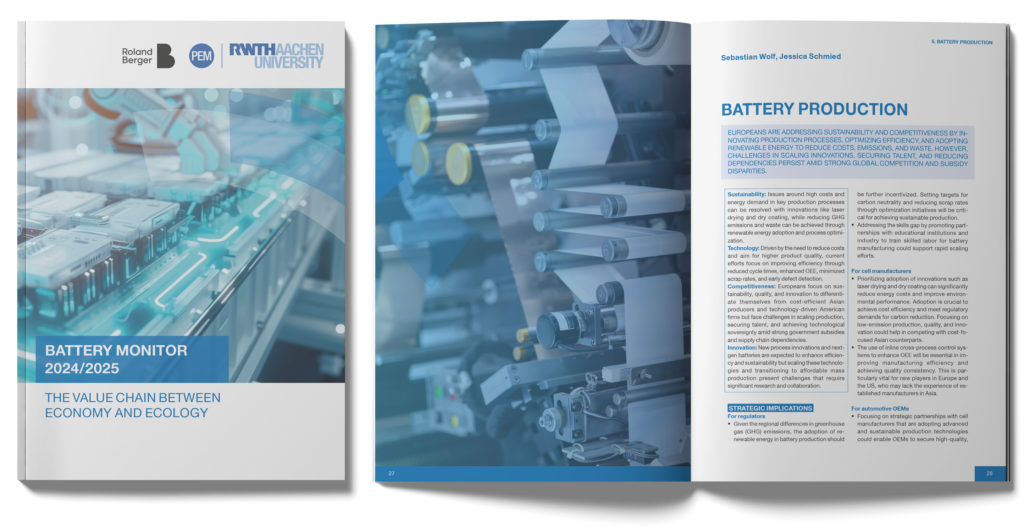Together with global cosultancy Roland Berger, the Chair of Production Engineering of E-Mobility Components (PEM) of RWTH Aachen University has published the “2024/2025 Battery Monitor”. According to the study, global demand for batteries will triple to up to 4.6 terawatt-hours by 2030 and double from there by 2040. The European battery market is currently characterized by a price war between Asian manufacturers. The authors claim that local overcapacities due to overly optimistic demand assumptions from China are causing prices to fall worldwide and are putting further pressure on European manufacturers, who are already struggling with higher production costs and uncertainties during the ramp-up of electric mobility. According to the Battery Monitor, new players in Europe will have to produce high-quality battery cells more cheaply in future, whereby collaboration with Asian competitors could prove useful.
“Despite considerable uncertainties, the global battery market continues to grow strongly and thus also offers opportunities for European manufacturers if they focus on competitive advantages through innovations, high-quality process technologies, and the eco-balance of batteries.”
“Despite considerable uncertainties, the global battery market continues to grow strongly and thus also offers opportunities for European manufacturers if they focus on competitive advantages through innovations, high-quality process technologies, and the eco-balance of batteries,” says PEM Director Professor Achim Kampker. “In 2024, the volatility in the market for battery cells has increased significantly,” summarizes Wolfgang Bernhart, Partner at Roland Berger. ”This is mainly due to uncertainties regarding demand, because the number of e-cars sold is increasing more slowly than expected and it is uncertain how the regulatory situation will develop in both the USA and the EU.” The study therefore presents three forecasts for the development of demand: a positive assumption that assumes a rapid progression of electrification, a baseline scenario that predicts the achievement of emission targets in the EU and the US despite a temporary decline in e-car sales, and a negative case with significant delays, for example due to a postponement of the “combustion engine ban” in the EU.
Surplus from China causing problems in Europe
On the global market, China is currently producing significantly more batteries than its own market demands, meaning that the surplus is being exported. This is leading to falling prices worldwide, but they cannot remain this low, as some suppliers and producers in China are already no longer covering their costs. At present, however, the fall in prices is putting pressure on European manufacturers in particular, who are working on building up their own capacities and could therefore theoretically cover more than European demand. According to the Battery Monitor, however, not all announced projects will be realized. Companies in the EU and the USA have recently made advance investments in vain and are now being extremely cautious in their investment plans, which in turn poses the risk of an undersupply. “This trend is also being driven by delays in industrialization and a lack of economic competitiveness,” says Kampker.
“It is unlikely that European or North American companies will ever be able to catch up with the Chinese cost advantage and access to raw materials for the same products and technologies.”
However, European battery manufacturers are focusing primarily on sustainability in order to set themselves apart from their Chinese and US competitors. The aim is to reduce emissions in the production of battery cells to up to 40 kilograms of carbon dioxide per kilowatt-hour. This corresponds to around a third to a half of the current carbon footprint of battery cells. This is a potential competitive advantage for Europeans, says PEM management member and battery expert Professor Heiner Heimes. “Especially as it is unlikely that European or North American companies will ever be able to catch up with the Chinese cost advantage and access to raw materials for the same products and technologies.” Another starting point for the industry is realistic progress in cell chemistry. “Those who gear their production plans towards innovations such as new, cost-effective battery types for small and mid-range electric cars at an early stage can move into mass production more quickly,” Heimes says.
Free download available
The 2024/2025 Battery Monitor is available as a free download in our Downloads section.



